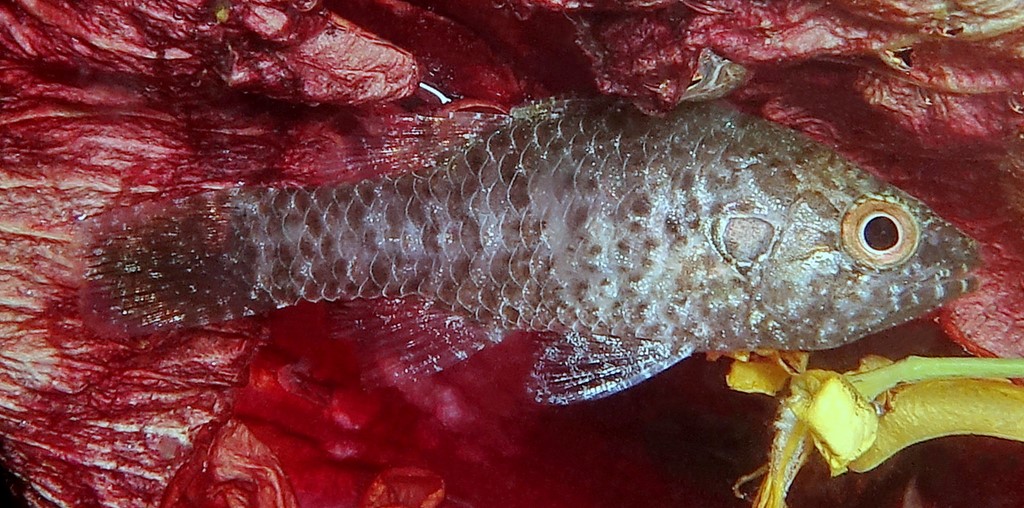FOWLERIA VARIEGATA - (VALENCIENNES, 1832)
Picture courtesy of: Jack Berthomier (Flicker)
Actinopterygii (Gigaclass) > Actinopteri (Class) > Teleostei (Subclass) > Gobiiformes (Order) > Apogonoidei (Suborder) > Apogonidae (Family) > Apogoninae (Subfamily) > Fowleria (Genus)
Variegated cardinalfish, Spotted cardinalfish, Peppered cardinalfish, Multi-spotted cardinal-fish, Shibori, シボリ, 多斑乳突天竺鯛,
Synonymes
Amia variegata (Valenciennes, 1832)
Apogon punctulatus (Rüppell, 1838)
Apogon variegatus (Valenciennes, 1832)
Apogon variegatus (Fourmanoir & Crosnier, 1964)
Apogonichthys nafae (Snyder, 1909)
Apogonichthys variegatus (Valenciennes, 1832)
---------------------------
Description
Dorsal spines (total): 7; Dorsal soft rays (total): 1 + 9; Anal spines: 2; Anal soft rays: 8; Pectoral fin rays: 12-14 (usually: 14); Lateral line scales: 23 (23rd overlapping caudal fin base), 6-12 pored scales followed by 11-17 pitted scales; Median predorsal scales: 4-6; Scales ctenoid on head and body; Total gill rakers: 3-4 + 11-13; Developed rakers: 1+ 5-6; Rear edge of preopercle ridge smooth, the lower edge membranous and crenulate; Suborbitals and posttemporal smooth. Body depth: 2.5-2.95, head length: 2.3-2.4 in SL; Snout length: 4.2-4.5, eye diameter: 3.1-3.8, interorbital width: 5.8-7.05, and upper-jaw length: 1.9-2.0, all in head length; Jaws and vomer with villiform teeth in bands, None on palatines; Caudal peduncle depth: 1.15-1.45 in peduncle length, and peduncle length: 4.2-4.7 in SL; Round shaped caudal fin. Max. length: 8.0 cm TL. Depth range: 0 - 27 m.
Color
Etymology
Fowleria: named in honor of ichthyologist Henry Weed Fowler (1878-1965), Academy of Natural Sciences of Philadelphia, and a student of Jordan’s at Stanford University + from Latin suffix, -ia = belonging to.
variegata: from Latin, variego = variegated, Streaked, spotted, speckled, or otherwise marked with a variety of color, very colorful. Referring to reddish body color mottled with “varied cloudy spots”.
Original description: Apogon variegatus Valenciennes, 1832 - Type locality: Mauritius, Mascarenes, southwestern Indian Ocean.
Distribution
Biology
Found in coral reefs and seagrass beds of inner bays and shallow lagoons; Also in dead reef and rubble. Nocturnal species. Solitary or in small groups. Distinct pairing during courtship and spawning.
Head and body with small, varied, dark marks not forming lines; Cheek mark pale and irregular, edged in darkish blotches above and below, sometimes curving downwards; Large dark spot on opercle with pale ring and then comma-like narrow dark outline, front of spot squared off parallel to edge of preopercle, rounded posteriorly; Fins mottled, with dark and pale areas generally connected to appear semi-linear, except pectoral fins transparent
Etymology
Fowleria: named in honor of ichthyologist Henry Weed Fowler (1878-1965), Academy of Natural Sciences of Philadelphia, and a student of Jordan’s at Stanford University + from Latin suffix, -ia = belonging to.
variegata: from Latin, variego = variegated, Streaked, spotted, speckled, or otherwise marked with a variety of color, very colorful. Referring to reddish body color mottled with “varied cloudy spots”.
Original description: Apogon variegatus Valenciennes, 1832 - Type locality: Mauritius, Mascarenes, southwestern Indian Ocean.
Distribution
Red Sea; Indo-West Pacific: East Africa, Persian Gulf, Aldabra (Seychelles), Comoros, Madagascar and Mascarenes (Mauritius) east to Philippines, Tonga and Samoa, north to southern Japan, south to Western Australia, New South Wales (Australia) and New Caledonia.
Biology
Found in coral reefs and seagrass beds of inner bays and shallow lagoons; Also in dead reef and rubble. Nocturnal species. Solitary or in small groups. Distinct pairing during courtship and spawning.
Similar species
Fowleria polystigma (Bleeker, 1854) - Reported from Western Pacific.
Last update: 18, July 2024
Last update: 18, July 2024
